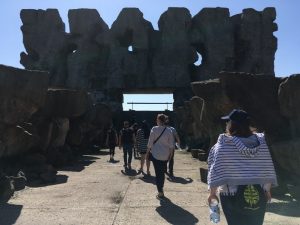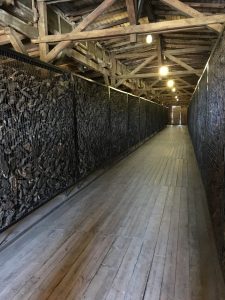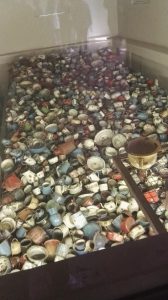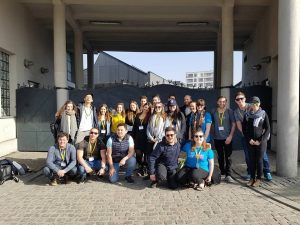HMDT Blog: March of the Living and the community of learners
In April 2018, three members of the Holocaust Memorial Day Youth Champion Board took part in the UK delegation for the March of the Living. The international educational programme, which brings people from across the world to Poland, involves travelling to various memorial sites before a memorial walk from Auschwitz I to Auschwitz-Birkenau.

In this blog, Anna Cardy, Nikos Souslous and Niamh Hanrahan share their experiences of the trip.
Nikos:
Since my return from Poland following the conclusion of this year’s March of the Living with the UK delegation, I have had several long conversations with friends and family, in a vain attempt to explain to them what I saw, what I felt, and what it was that made those five mid-April days across Poland so special.
Though it is difficult to imagine that I will ever forget what it was like to visit the camps of Majdanek, Belzec, or Auschwitz, to stand in the mass execution forest at Zbylitowska Góra or to walk around the former sites of the Warsaw and Krakow ghettos, it may yet be the case that, instead, it is a general impression that stands the test of time. Without a doubt, what I will always remember from this trip, what made it so great and so unique, was that I felt I belonged in a close-knit and vibrant community of learners.
It was a privilege to be able to travel across Poland and learn more about something that I feel so strongly about while being in a group of like-minded individuals of different backgrounds. At every stop along the way our knowledgeable educator and the team of guides would explain to us the significance of a given place and its wider relevance to the Holocaust and the history of the Jewish community in Poland, and they were always ready to engage with all our questions. Most importantly, group discussions and activities that encouraged us to share our thoughts, emotions, and impressions were an integral part of the learning process and one that, along with the numerous chats I would have with people throughout, I will always cherish.
Our learning was undoubtedly enriched by the time we spent time with Arie Schilansky, a survivor of the Holocaust. As part of the trip, every group is accompanied by a survivor who shares their experiences, answers our questions and gives a more personal account of the places we visit. It was inspiring to witness the dedication and energy with which Arie lead us across Poland and to hear his powerful testimony which helped us comprehend the personal impact of the Holocaust and the importance of remembrance. What struck me the most, however, was that despite his age and his first-hand knowledge of the Holocaust, Arie was also a keen and enthusiastic learner himself. Like everyone else, Arie asked our educators questions, he took notes and photos, and participated in all our group conversations and activities. His remark at the end of the trip that it had given him a lot to think about and reflect on is the greatest reminder of the value of lifelong learning.
The Holocaust Memorial Day Trust’s Youth Champion programme seeks to help young people learn more about the Holocaust and subsequent genocides, and to empower them to promote Holocaust and genocide education in their own communities. I am confident that anyone who has ever been involved with the programme would enjoy and benefit from participating in March of the Living, just as I and my fellow Board members did. It is not only those that have worked with HMDT that would find it worthwhile. If you are interested in the Holocaust and subsequent genocides, if you want to know more about Jewish, Polish and other communities both in history and today, if you look forward to a safer and better future free of the evils of the past or, of course, if you are passionate about learning and education, then this trip will be beneficial to you.
Niamh:
Although the March of the Living concluded in Auschwitz, we visited many different types of memorial sites throughout our week in Poland. Some, such as Majdanek, had visible signs of Nazi atrocities such as barracks and gas chambers, whereas in others it was the absence of evidence that made the space jarring, for example at Belzec and Zbylitowska Gora. 
Majdanek was established in 1941, with gas chambers and a crematorium being added in 1942. Around 78,000 people were killed at the site. We visited on the second day of our trip, and we first went to the large memorial at the front of the camp.
From here, much of the rest of the camp can be seen and we had interesting discussions about the role of bystanders in the Holocaust. Unlike other extermination/concentration camps I had visited previously, the majority of which were in forested areas or on the outskirts of a populated area, the town of Lublin was extremely close to Majdanek.
 We visited barracks, some of which had been transformed into display spaces, showing how prisoners slept, the history of the camp and piles of shoes of those who had been killed by the Nazi regime. Whilst we were walking, our educators Oliver and Ola would inform us of the historical significance of the places we were looking at and Arie, the Holocaust survivor with our group, would tell us stories from his life that related to what we were seeing. Having the combination of both historical knowledge and personal accounts was invaluable.
We visited barracks, some of which had been transformed into display spaces, showing how prisoners slept, the history of the camp and piles of shoes of those who had been killed by the Nazi regime. Whilst we were walking, our educators Oliver and Ola would inform us of the historical significance of the places we were looking at and Arie, the Holocaust survivor with our group, would tell us stories from his life that related to what we were seeing. Having the combination of both historical knowledge and personal accounts was invaluable.
The next day we visited Belzec extermination camp, also in the Lublin district. Compared to the huge area that Majdanek occupied, Belzec was very small and built solely for extermination purposes, running from 1942 to 1943. Also unlike Majdanek, it was not liberated but decommissioned by the Nazis, who planted trees and plants and rebuilt housing to make it appear as though a farm had been on the plot for the entirety of the war.
We arrived at Belzec early in the morning before any other visitors had arrived. The emptiness of the space both in terms of memorialisation and people was quite unnerving. In the main memorial space, some of our group recited the Kaddish in memory of those who had lost their lives in the space we were in. I am not Jewish, so this experience was quite unusual for me and made all the more emotional by the setting we were in. To hear Jewish remembrance taking place loudly and defiantly in a space where extermination and terror had occurred is something I will never forget.
On the same day, we visited the forest at Zbylitowska Gora. Here there are memorials around the mass graves of those who died in mass shootings in the forest, including a children’s mass grave. There is one large memorial, created by the Soviets, and personal items left by visitors around the graves.
Having our bus community to discuss feelings and thoughts with was extremely beneficial – at Zbylitowska Gora we were able to talk about memorialisation and how memorials serve different sites in different ways. Therefore, as well as being a moving experience, visiting all of the sites that we did was also a highly educational one too.
Anna:
‘Those who do not remember the past are condemned to repeat it’ – George Santayana
The quote on display in barrack 11 resonates throughout the whole of the time spent in the camp. Auschwitz has become a symbol of the Holocaust and is a constant reminder of what humanity can do if it lets prejudice and discrimination take hold.
We spent 2 days in Auschwitz that were of major contrast; the first of sombre reflection and the second of looking to the future.
The first day we entered the camp through the infamous gates that read ‘Arbeit Macht Frei’ – ‘Work Sets You Free’, a strong realisation that many of those who went through the gate never came out. There are many things that I remember from the journey through the camp; the rooms of belongings with no owners, the photographs of the people on the transports and the meticulous documents made by the Nazis. All of these held in a place where death and despair seep through every inch of its existence.
From Auschwitz I we headed to Auschwitz-Birkenau where parts of the camp had been destroyed after the Nazi retreat. The sheer scale of the camp is unfathomable. For as long as the eye can see there are barracks, watch towers and the remains of the gas chambers and crematoria. From the train tracks through to the ramp where selection took place, there was no escaping from the emotions that took hold. It was in one of the barracks when the enormity of the visit hit us. A survivor with another group cried ‘do you think I want to be here – do you think it doesn’t tear my soul in two just being here again! But I have to – you have to listen – you have to tell’. The pain and emotion that he goes through every time he relives his experiences makes us question how can anyone deny or belittle what happened here.
Throughout the trip there were times where Arie would stop and tell us of his experiences. He told us about the cattle truck in which he was transported to Stutthof Concentration camp and then later to Dachau Concentration camp on a death march.
Our group march on the second day had a completely different atmosphere; we were now celebrating life. We began at Auschwitz I where we congregated with delegations from throughout the world.
 There is no right way to take the march, some people embrace the opportunity to meet people from all over the world and swap items whilst some people take it as a sombre time of reflection and realisation.
There is no right way to take the march, some people embrace the opportunity to meet people from all over the world and swap items whilst some people take it as a sombre time of reflection and realisation.
The march ended at a ceremony at Birkenau, where we heard from survivors and various political leaders including the Presidents of Poland and Israel. Throughout the ceremony there were messages of strength, unity and defiance. It was also a day of encouragement; 20,000 people gathered in one place to actively remember what happened in the Holocaust and would spread the message of never again.
We would like to say thank you to March of the Living, especially those on Best Bus B – you shared the journey with us and taught us so much.
We dedicate these blogs to Arie Shilansky, the survivor who travelled with us throughout the week. Thank you for sharing your story with us, your strength and courage is remarkable. You captivated us and showed how important Holocaust education is.
The HMDT blog highlights topics relevant to our work in Holocaust and genocide education and commemoration. We hear from a variety of guest contributors who provide a range of personal perspectives on issues relevant to them, including those who have experienced state-sponsored persecution and genocide. The views expressed are those of the author and do not necessarily represent the views of HMDT.